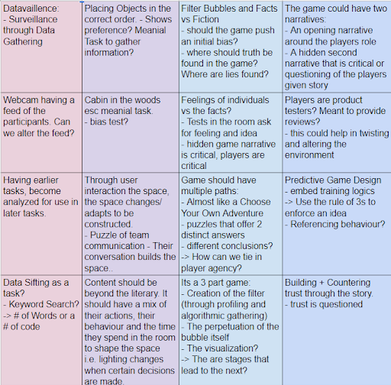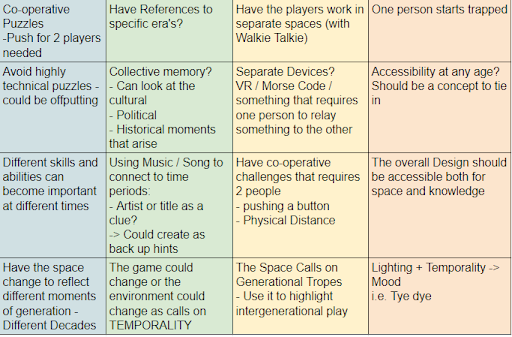This is a blog post from my Masters work which was conducted in 2018-19. It is a re-post from the original site where the blog was held and was only slightly adjusted to the new website. If you are interested in the larger project you can read the thesis here.
How do we come up with creative ideas? It seems everyone has their own approach. You might listen to music, go on walks, write it out, or perhaps take a long hot showers to let ideas flow. I’m someone who typically chews on my ideas, letting them shift and grow. I try to think about them in different environments, distinct contexts, or late at night as I try to fall asleep. Eventually, I will write them down, and after a month of chewing I went into a deep brainstorming process. I spent three full days, each dedicated to brainstorming a different difficulty of the puzzle, followed by another two months of refining, revisiting and addressing. This post will go over the initial brainstorming days and the process of establishing those sparks.
Day 1:
Each brainstorming session followed similar methodologies. As a visual learner, I traveled into the Technoculture, Arts and Games (TAG) space at Concordia, to use their large chalkboard. I split it into a 4 by 4 grid and began to fill it out, colour coding each section based on similarity in idea. For the first day, I wanted to get a range of ideas. Each square of the grid was filled in with an idea related to one of the research concerns I had (Intergenerationality, Surveillance, Filters, Co-operative Experience, Environmental pieces etc.). This process was fast with ideas I had been sitting on for the past few months quickly filling the space. However, as I kept going I found myself returning to the literature, asking questions about the logistics of options, and opening my thoughts up to new ideas. The goal today was not what the game would be specifically, but what it might look like, what it could include. I wanted to brainstorm the overall concept, and many other possibilities or ideas that could go with it.

I ended up making two grids, giving myself 32 ideas towards starting the design process. The work session was helpful in centreing my thought moving forward. I had new questions about accessibility, budget, physical limitations, understanding my own skills in relation to my ideas. For example, I briefly considered VR, but due to lack of coding, access to the technology, and security challenges of storing it in a space, that it made little sense to pursue (though I still think it would be cool). I then documented both grids, taking photos and translating to a digital format I could keep editing and refer to in design.
Day(s) 2

Building off of the previous session, I dedicated two half days to working on more of the specifics. I used the ideas from day one to guide conversation with games scholars and spark ideas for more specifics on how it might be done. I used pencil and paper to write down thoughts, start drawing basic ideas, making lists of questions or needs, and begin mapping out puzzle paths. While this got very messy very fast, I continued to carry the paper with me, filling it with ideas and questions. The ‘session’ became extended beyond the half-days spent, into slightly over a week of jotting down ideas, reworking a concept, and constructing an approximate puzzle pathway. Research is messy, but in the mess ideas began to form. While this process made me constantly think about the game, it was beneficial to garner ideas and perspectives as I noticed myself weaving it into daily conversation.
Day 3:
Eventually the mess of papers became too much. I was getting confused on where I had written things, and more questions started to pile up than solutions. So, I traveled back to TAG on a quiet weekend, sat down with all my papers, bookmarked readings, and their chalkboard to map out the game. I broke the game into chunks. Exploring each puzzle path from start to finish as separate entities. I then created the connections between the two, recognized where the literature intersected with the puzzles, and configured a workable blueprint for the game. I took the data from the paper and mapped it onto a board. By the end, the game was broken into 3 major puzzle paths, the ideas I wanted to include were accounted for (or so I thought), and, while I still had questions, I felt confident to work on the first prototype/iteration of the game.

Once again, I typed up what I created, developed a material list, and a budget and have since started to piece it all together. While I am going to return to my interviewees with this blueprint, I am at the start of having the tangible game. For now, I am not going to include the document that outlines the entire game, as some people might not want to be spoiled before playing the game.
Brainstorming is a unique part of the research process, and in this case encompassed my life for about a month and a half. Taking my time to think about each part, and continually reflect it on the literature was important to make sure I was maintaining the objective of the game. There is too large a process to all put here, but I will continue to talk about the puzzle paths as they get constructed and the overall notions of educational games.





Commentaires